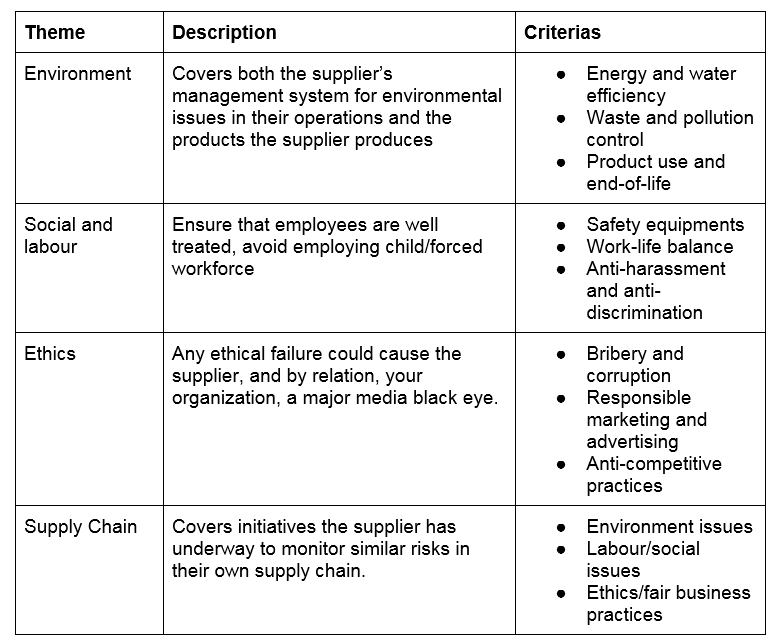
It is no secret that modern supply chains are increasingly exposed to risks that can result in increased operational costs, large losses, and long term damage to your corporate reputation. Predictable risks are still causing significant losses on a daily basis. Many organizations are losing millions, and in some Global 3000 cases, billions of dollars a year due to ineffective supply chain risk management and monitoring.
One big reason that companies cite for this is silo’ed efforts: in most organizations, Risk Management is fragmented, especially those risks related to suppliers’ performance and practices in Corporate Social Responsibility (CSR). With different departments doing their own risk assessment and mitigation projects that are looking at risk from different perspectives, suppliers are either overburdened, overlooked or under-assessed; screening yields false-negatives or false-positives; correlated risks are missed, and efforts are duplicated.
Many procurement teams are finding holistic approach can provide huge advantages. With a common sustainability and compliance initiative through centralized CSR program that not only proactively assesses all suppliers but includes an ongoing monitoring initiative. Here’s an overview of the important criteria to consider when searching for a solution:
What is the Industrial Breadth of the Solution?
No matter what sector your business is in, you will source across dozens or even hundreds of purchasing categories, particularly when you consider indirect spend where many risks can be hidden. Your organization may know very little about many of these industries, especially when it comes to risk and CSR. For example, CPG, Pharmaceutical, or High-Tech companies all will use office supplies, require MRO to maintain buildings and machines, run its software on high end computers, require temporary services, require marketing and advertising agency support, require legal assistance, and so on.
The type and severity of CSR-related risk exposure can vary widely by category or industry both as a result of the business activity (for example labor risks in manufacturing, environmental risks in chemicals, ethical risks in extraction industries, and so on). Each industry has its own set of regulations (environmental, anti-bribery, and worker’s rights legislation, etc.), which can vary by geography. A best-in-class supplier monitoring solution should be adapted to this diversity in how it assesses supplier performance.
To cover this breadth of industry, country, and regulatory variety also requires monitoring news sources, government sources, NGOs, industry association sources, user groups, third party forums, and so on. This will require a solution with the capability and scale to monitor and analyze all of these different data sources.
What is the Depth of Supplier Coverage?
When looking at the CSR assessment process, it should address all major sustainability and CSR themes including environmental responsibility, ethics, social responsibility and worker’s rights, etc.
The following table gives some examples of criteria that can be taken into account during a CSR assessment:

Actionable, Benchmark-able Metrics and Insights
It’s not enough to have a supplier assessment: The assessment should be digestible and actionable by the Procurement team. An in-depth report on a supplier from a third-party isn’t always the right format to be actionable by a purchasing or category manager. How do suppliers CSR performance compare to their peers? What is the norm for the industry or geography they are in? Are they improving their sustainability over time?In order to achieve this depth of coverage, the solution must monitor a diverse range of sources and be aligned with international standards.
Solutions that quantify sustainability performance let procurement teams quickly evaluate each supplier against a common standard and determine how the supplier stacks up against its peers and overall. A 5 out of 10 might be a bad rating overall, but if most suppliers in the industry in the region the supplier is located in score 3, the supplier shows promise and is a candidate for sustainability improvement.
This system should also allow a buying organization to quickly filter out suppliers who don’t meet organizational thresholds. Quantifiable measurements such as ratings also allow a buyer to set targets and thresholds, which can be used to engage the supplier in taking ownership of their performance: When ratings drop below a threshold they may trigger a Corrective Action plan. If they perform above the benchmark, this can be used as the basis for recognition such as supplier awards, or in more advanced cases eligibility for preferred supplier programs.
Sustainability performance metrics also enable creation of risk maps. This can help reveal relative supplier risk compared to average risk of the region or purchasing category.
What is the Extent of Integration and How Easy is the Solution to Integrate?
In order for your procurement team to adopt the use of information on ethics, corporate social responsibility, and sustainability information in their jobs, it should be integrated into the supply management platforms such as e-Sourcing, e-Procurement, CLM, SRM. This simplifies and automates the use of CSR criteria in the procurement workflows and processes.
Thus it’s essential that the solution come with an API (and that the CSR data and indicators are suitable) that can be used to integrate the platform you are using. When the full team has access to current and complete sustainability data, everyone knows:
- whether a supplier has been assessed and, if so, it’s associated risk rating and whether or not the supplier should even be under consideration
- whether a supplier has an associated risk indicator or warning and what investigation needs to take place to judge the risk
- the % of spend with suppliers that have a desired sustainability rating and how spend with a given supplier would affect that rating
Ideally, the platform comes integrated out-of-the-box with major ERPs and applications traditionally used for risk management to save the organization work.
Service: What Level of Change Management Support is bundled with the solution?
Just plugging in a world-class assessment and monitoring platform is not sufficient to transform the organization and tackle supply chain risk management. You may have to undergo a major change both in risk management process and philosophy.
Not only does a new process have to be implemented — which may be replacing silo’ed/ piece-meal efforts, and not only does a platform have to be selected that supports this, but the key players in each team or function has to buy in, use the standard CSR ratings/indicators and scorecards and centralized platform, and adopt the new, common view of supplier risk management and monitoring.
This is a change management initiative as much as it is a solution selection and implementation initiative. Look for a solution provider that offers the resources to help you review and refine your processes, integrate your systems and data feeds into their system, and help your staff accept and embrace the change and drive toward adoption and success.
Summary
There are a wide variety of approaches to sustainability and risk management. If you are selecting a solution, these criteria should help ensure you cover the key aspects.
The right platform will encompass the needed breadth of industry monitoring, depth of supplier monitoring into a set of actionable metrics and insights. In addition to an online platform, these metrics and insights should be accessible via API from various procurement software.
If you have questions or comments on selecting supplier CSR monitoring tools, contact us here for a consultation.
This blog post is based on the white paper “Five Essential Criteria For Selecting A Supplier Sustainability & Risk Monitoring Solution” by Michael Lamoureux of Sourcing Innovation, available here in the EcoVadis library.
Continue Reading:
Leveraging EcoVadis Assessment Results to Support GRI Reporting
Sustainable procurement programs on the rise, still face challenges: EcoVadis Barometer results

